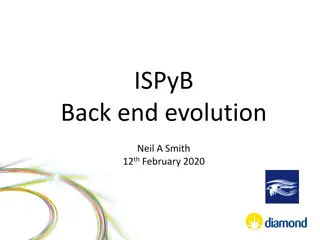
Dynamic Light Scattering in Colloidal Systems
Explore the fundamentals of dynamic light scattering in colloidal systems, from setup to analysis of scattered light intensity. Learn about correlation functions, decay time scales, and size scales in diffusive motion. Discover the significance of fluctuating signals and the correlation function in characterizing particle motion.
Download Presentation

Please find below an Image/Link to download the presentation.
The content on the website is provided AS IS for your information and personal use only. It may not be sold, licensed, or shared on other websites without obtaining consent from the author. If you encounter any issues during the download, it is possible that the publisher has removed the file from their server.
You are allowed to download the files provided on this website for personal or commercial use, subject to the condition that they are used lawfully. All files are the property of their respective owners.
The content on the website is provided AS IS for your information and personal use only. It may not be sold, licensed, or shared on other websites without obtaining consent from the author.
E N D
Presentation Transcript
786 DLS Basics
Dynamic Light Scattering: Setup Incident light Diffusing colloids Transmitted light Scattering angle Light scatters in all directions Detector Fluctuating scattered light intensity Fluctuations in scattered light arise from diffusion
Scattered Light Intensity: t = 0 Particles in fixed positions Incident light Unperturbed light If particles remain fixed, so does intensity at detector Detector I = I0 Static scattering reveals micro-structure; e.g. x-ray crystallography
Scattered Light Intensity: t = t Particles have diffused Incident light Unperturbed light If particles move, intensity at detector changes Detector I = I( t) = I0 Duration of t before intensity changes gives time scale of motion Dynamic light scattering reveals ensemble average motion
Signal fluctuates in time How fast? Over what time scale? Instrument calculates correlation function:
Compare the signal I to itself: I(t') I(t'+t) I(t'+2t) I(t'+9t) . Dt Lag time: I(t'+Dt) I(t') If: , then is large I(t'+Dt) I(t') As: , then diminishes G(Dt) G(Dt)
What does the correlation G look like? Siegert approximation Where Raw data: exponential decay Thought experiment: if this is an example correlation function for a randomly fluctuating signal I, what would the correlation function look like if the signal I was sinusoidal? Otherwise periodic?
Meaning of decay time-scale Fluctuations in scattered light arise from diffusive motion Correlation function of scattered light intensity: exponential decay Detector Real-time hardware correlators measure lag time t at which I( t) = I0
From time-scale to size scale Units of Diffusion = [length2/time] Length scale given by scattering vector q ( )l q= 4pnsinq2 l: laser wavelength J : scattering angle n: solvent index of refraction q has units 1/length; can be controlled by adjusting Diffusion through area 1/q2 occurs at time scale
Measured Diffusion Constant Diffusion D has units length2/time Time is , as obtained through exponential fit Length scale is 1/q. Area particle diffuses through in length scale is 1/q2 1 Hence measurement of D is: D= q2t
Particle size from D Use Stokes Einstein relation, assuming spherical particles: h: Viscosity of medium a: Radius of particles D=kBT 6pha, where: Combine measured D with Stokes Einstein: D=kBT 6pha= 1 q2t and solve for radius a a =kBT 6phq2t






















